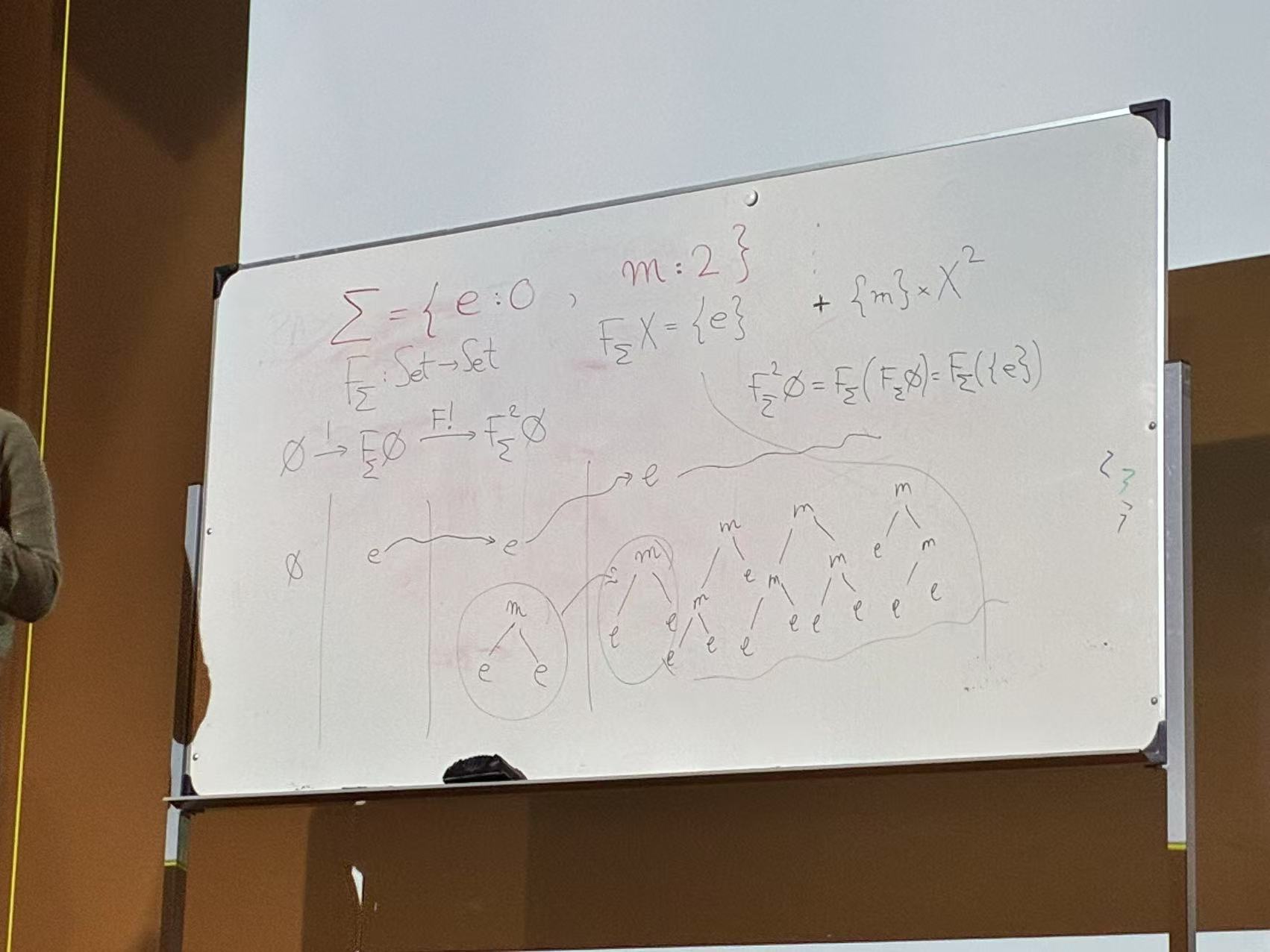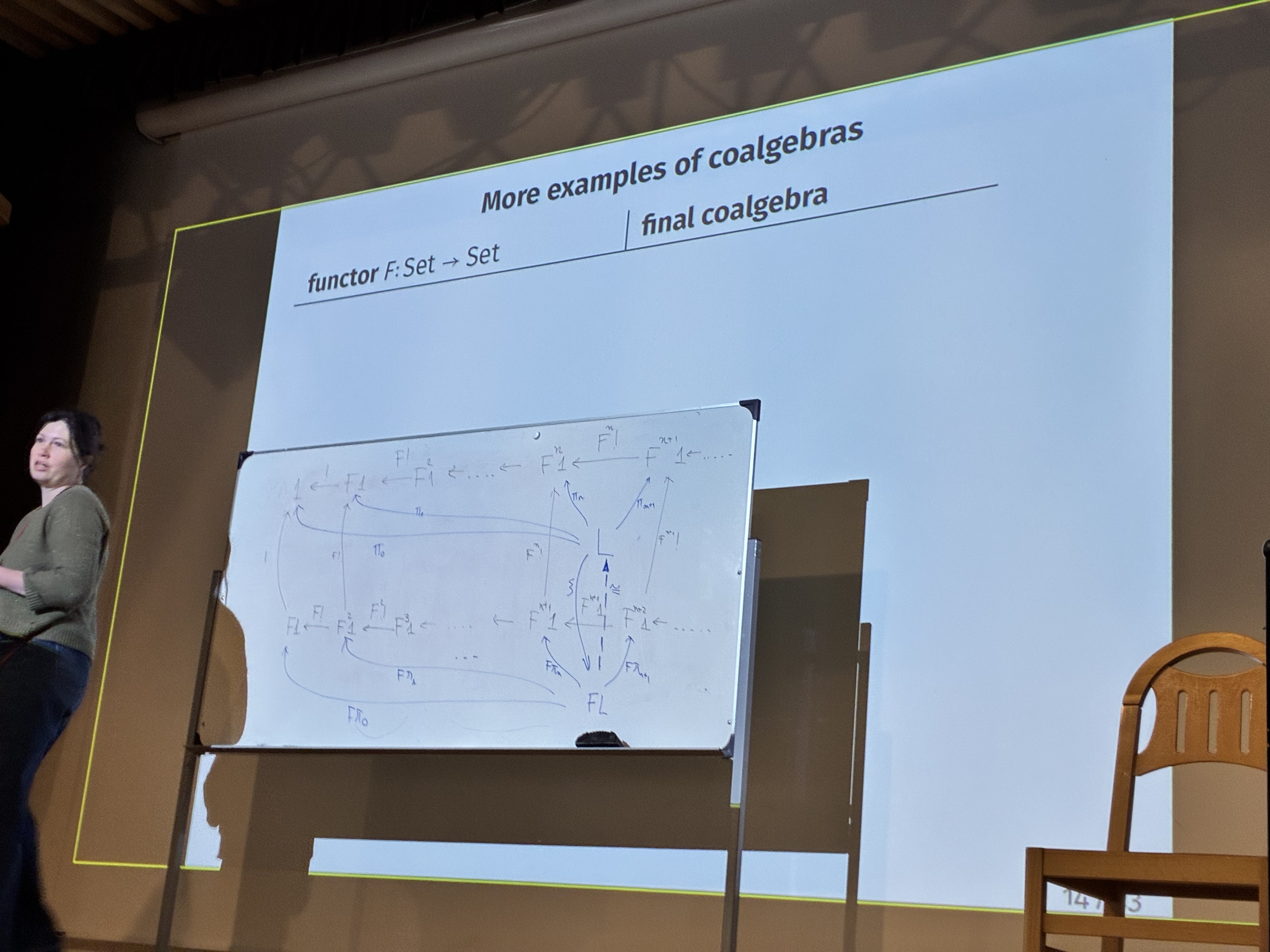Basics of category theory (Farzard)
Introduction
- monoid = element + binary operation (assoc + unit element)
- can be considered as a function from singleton to the set
- , applying
- We can do the same for groups:
Different structures can be presented by the same diagram in different categories.
Definitions
- A metagraph:
- objects
- arrows
- dom: arrows → objects
- cod: arrows → objects
- A metacategory is a metagraph s.t.:
- id
- assoc of
- unit law for and
Examples:
▶ Sets: Objects are all sets; arrows are all functions with the usual composition. ▶ Groups: Objects are all groups; arrows are all homomorphisms of groups. ▶ Topological spaces: Objects are all topological spaces; arrows are all continuous functions. ▶ Hausdorff spaces with continuous functions. ▶ All ringed spaces with their morphisms.
MetaCat → Cat
- A directed graph (note that defined on set of objects, arrows, and composable pairs of arrows)
- A (small) category is a directed graph such that …
- Exercise: Is this definition just a monoid for the product ×O.
Is Sets a category?
Large Categories
We consider all the “small” sets Let be a big enough set, the universe, a set is small if
- Set: all small sets, and all functions between them.
- Pointed sets Set⋆: all small sets with one distinguished element ⋆, and all ⋆-preserving functions.
- Mon: small monoids, and monoid morphisms. ▶ Grp: (small) groups, and group morphisms. ▶ Ab: (small) abelian groups, with morphisms of such. ▶ Rng: (small) rings, and ring morphisms. ▶ R-Mod: left modules over the ring R, and linear maps. ▶ Top: (small) topological spaces, and continuous maps.
- Cat: small categories, and functors.
- A category is small, if set of its objects and the set of its arrows are both small.
Foundations
- Set is not a small category
- ZFC + existence of U suffices for the usual purposes of category theory
- One needs to define the notion of universe U in such a way that its properties ensure that any standard operation of set theory applied to elements of U will produce elements of U.
- See here for more discussion
Functors
morphism of categories
- preserves composition
- preserves identity
Complete Category
Natural transformations
- for functiors and
- that satisfies the commutative diagram
- An isomorphism is a natural transformation such that is an isomorphism for all in the category.
How to build categories
Product of two objects
- described by: forall in , there exists a unique arrow and such that
- can be extended to arbitrary number of objects
Terminal Object
of a category is just the empty product
- decsribed by: forall in , there exists a unique arrow such that
Coproduct of two objects
- e.g. Set = disjoint union of sets
Initial Object
the empty coproduct
Opposite category
idea: is the co/contravariant functor related to w\subtyping
Presheaf
A presheaf on a category C is a contravariant functor from C^op to Set. ⇒ Yoneda embedding
Products of categories
- object = pair of (X, Y)
- morphism = pairwise morphism
Example:
- Covariant bifunctor from
C^op X C -> Setsending (X, Y) to hom(X, Y) - The contravariant bifunctor from
C^op X C -> Setsending (X, Y) to hom(X, Y)
can be encoded by compositions of unary functors on
C^opandC
Right adjoint
- A profunctor from D to C:
C^op X D -> Set- The hom bifunctor is a indentity profunctor
C --/-> C… todo
- The hom bifunctor is a indentity profunctor
Adjoint functors
- a pair of adjoint functors between posets is a Galois correspondence
- free: Set → Grp is the functor gives us the free group on a set
- The forgetful functor Grp → Set is right adjoint to …
Functor Categories
- objects are functors
- morphisms are natural transformations
Comma Categories
- objects are pairs of objects and morphisms
- morphisms are morphisms that commute a diagram
Set / *isoSetisoSet/ *
Remark 1: An object
X : Ccan be view as a functorX : 1 -> C, so we can encodeX / objusingX / functor
We can also define over a functor F : C --> D, X : D, define a new category X / F
also dually for F / X
Also F/G category over category is definable
Remark 4 : a natural trasformation
\theta : F -> Gbetween 2 functors is just the same as a functor C → (F/G)
Syntactic Category & Category of models
Another way to build category: using logic and models
Theories - (lambda terms, compilers between them )
| A
| |
| |
| |
| |
V |
Categories - (category of category, ... )
Depending on the theory, we need to assume our category have extra properties: e.g. cartesian products, limits, has images, … (need to be looked from the theory)
Limits and Colimits
cone, cocone limit, colimit
Basics of Coalgebra
- By Park and Milner, bisimulation as a notion of behavioural equivalence for concurrent processes
- Aczel’s theory: lift the bisimulation to the level of arbitrary coalgebras
Algebras
= (carrier) sets with operations e.g.: Nat + zero, succ : take a set add one extra element to it
e.g. with operations zero and flip : take a set add one extra element to it
Algebras for a functor
Definition. Let be a functor, An F-algebra is a pair consisting of an object of and a morphism in .
Example: M-algebra defined by for
Definition. A morphism between two F-algebras and is a morphism in such that the following diagram commutes:
Exercise. define a morphism of M-algebras
- to
- the
mod2function - to make the diagram commute
- the
Algebras for a signature
An F-algebra is given by a map . Then is just an algebra in standard notion
Coalgebras - the dual of algebras
Turning the arrows around, We will mess up with category
X → FX
Instead of constructors we start with destructors, how to destruct the state
Example. is tht set of inifinite streams of natural numbers,
Consider operations:
- head : Nomega → N
- tail : Nomega → Nomega
- Then their paring: <head, tail> : Nomega → N x Nomega
so it fits a coalgebra structure for the functor: Str:Set → Set, defined by Str(X) = N \times X
Morphisms of clalgebras
Say we have another Str-coalgebra: where
h : Nomega \times Nomega -> N
t : Nomega \times Nomega -> Nomega \times Nomega
with h(sigma, tau) = sigma(O) --- (identity)
and t(sigma, tau) = (\tau, tail(sigma))
The coalgebra morphism? zip : Nomga \times Nomega -> N\omega that respects the structure
spoiler:
zipis the final coalgebra, and we will use coinduction to prove that it is the unique one
think we are dualing in two aspects: the data/op filip and the finite/cofinte layout
Induction and Coinduction
Initial Algebras
F-algebras and their morphisms form a category Alg(F)
Let F be a functor The initial F-algebra is an initial object in the category Alg(F)
Example. (N, [zero, succ]) is the initial algebra for the functor 1 + -
initial algebra ----> !exists morphism ---> arbitrary algebra
so
- existece → definition by induction
- uniqueness → proof by induction
(List)A, [nil, cons] is the initial algebra for the functorTX = 1 + A times X
Dualize: Final coalgebra
F-coalgebras and their morphisms form a category Coalg(F)
A final F-coalgebra is a final object in the category Coalg(F)
We have examples of coalgebras that don’t have final coalgebras
<Nomega, [head, tail]> is the final coalgebra for the functor Str(X) = N \times X
Exercise:
even:
Algebras + coalgebras in preorders
a category C | a preorder (P, <=)
a functor F:C -> C | a monotone map f : P -> P
F-algebra: alpha : FX -> X | pre-fixed point f(x) <= x
F-coalgbra: eps: X -> FX | post-fixed point f(x) >= x
initial F-algebra | least pre-fixed point mu. f
final F-coalgebra | greatest post-fixed point nu. f
More examples
functor F : Set -> Set | final coalgebra
FX = A \times X | <head,tail>: A^omega -> A \times A^omega
FX = 1 + A \times X | A* + Aw -> 1 + A \times (A* + Aomega)
(with termination: finite list A* + infinite lists A\omega)
FX = P(X) (powerset) | Non, recall Lambek Lemma
(Kripke frames, the same as giving relation between states)
FX = P(L \times X) | Non, recall Lambek Lemma
(labelled transition systems)
(l, x') in F(x) means x' --->l x
FX = 2 \times X^A | <eps, der> : 2^{A*} --> 2 \times 2^{A*}
(deterministic automata)
FX = 2 \times (P(X))^A | No, if you stick to arbitrary powersets
(non-deterministic automata)
FX = (O \times X)^I | casual functions I* --> O*
(Mealy machine)
Coalgebras. can have finite structure, must infinite behavior e.g.
X = {1, 2, 3},A = {a, b},\eps: X -> A * XState:x1|a --> x2|b --> x3|a --> x2|b ....The final coalgebras will capture all the behavior of the systems modelled as F-coalgebras
x_1 |-> a(ba)^omega
Compute initial algebras as colimits
Theorem (similar to Tarski)
Let C be a category with an initial object O and colimits of w-chaines, Assume F preserves such colimits, then the colimit of the chain O ---!----> FO ----F!----> F^2O ----F^2!----> ... carries a structure of initial F-algebra (! for unique)
Example:
\Sigma = { o : 0, m : 2 } --- emp + binary operation
such that (F\sigma) X = { e } \times X^0 + { m } \times X ^2
~~ { e } + { m } \times X ^2

Computing final coalgebras as limits
Let C be a category with an final object 1 and limits of w^op chains. Assume F preserves such limits (in the proof, F L is also the limit, so we can invert the unique morphism, by def, L and FL are both the limit of the same chain), then the limit of the chain 1 <-!- F1 <-F!- F^2 1 <-- ... carries a structure of final F-coalgebra
Step 1 : L is the limit
 Step 2 : for X ⇒ FX, show that there is a unique morphism from X to L, as L is the limit
Step 2 : for X ⇒ FX, show that there is a unique morphism from X to L, as L is the limit
Step 3: show the unique morphism from X to L commutes (exercise)
Congruence and bisimulations
F-congruence
induction proof principle
F-bisimulation
coinduction proof principle: every bisimulation on a fina F-coalgebra X → FX is contained in the diagonal on X
Examples
- Labelled transition systems
- Streams:
- R in X times Y is a bisuulation iff for all (x,y) in R we have hd_X(x) = hd_Y(y) and (tail_X(x), tail_Y(y)) in R
Several notions
- Aczel-Mendler bisumulations
- Hermida-Jacobs bisimulations See https://arxiv.org/pdf/1101.4223